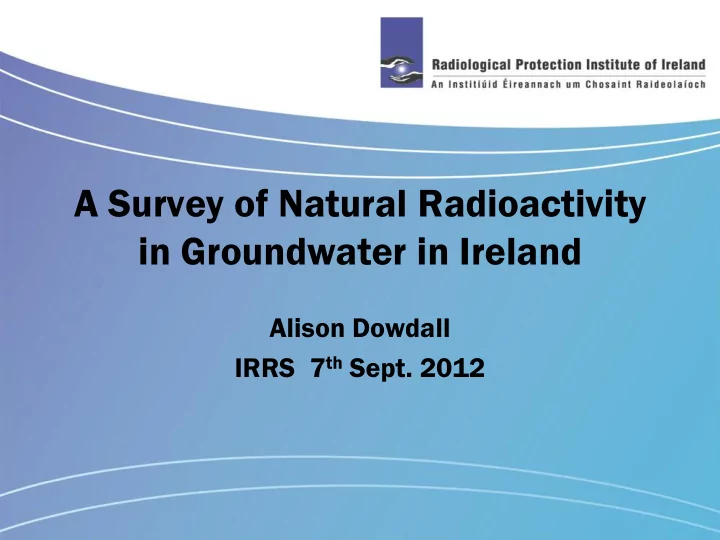

A Survey of Natural Radioactivity in Groundwater in Ireland Alison Dowdall IRRS 7 th Sept. 2012
Surface Water Supplies • Approx. 82% of drinking water in Ireland comes from surface water • Water from rivers, lakes, treated • Stored in reservoirs
What is groundwater? • Water in pore spaces of rocks and gravel • Where water deposit is sufficient to provide supply, it is termed an aquifer • Boreholes and springs or input to rivers
Groundwater supplies in Ireland • 18% of Irish drinking water comes from groundwater supplies, comprised of boreholes (10%) and springs (8%) • Approx 100,000 wells in Ireland (public and private)
Why do the RPII monitor water for Radioactivity EU requirements 1. Water monitoring required under Article 35 and 36 of Euratom Treaty 2. Drinking Water Directive, 1998 (DWD) Irish Legislation 1. S.I. 278 of 2007 • WHO Guidelines for drinking water, 1993 100 mBq/l gross alpha, 1000 mBq/l gross beta Further analysis if these are exceeded • Large surface water supplies
Objectives of the study 1. Knowledge gap regarding natural radioactivity in groundwater 2. Assess levels of natural radioactivity in groundwater for compliance with Drinking Water Directive and WHO guidelines 3. Assess levels of radon in groundwater with RPII recommended level 4. Publish the findings
Sampling • EPA Groundwater Monitoring points • Approx. 220 sites sampled quarterly • RPII samples collected by EPA as part of their sampling programme • Samples collected for radon analysis gross alpha and beta analysis radium polonium analysis
A wise decision!!
Analysis Drinking Water Directive 1998 Radon in Water • Groundwater sources screened (EU recommendation of 2001) using WHO screening limit of 100 mBq/l for gross alpha, 1,000 mBq/l for gross beta • Radon in water measured for 217 locations • Where a limit is exceeded, identify • 3 samples from each source radionuclide causing the activity collected • Uranium, polonium, radium • RPII recommended level of 500 • Drinking Water Directive - Total Bq/l indicative dose should be <0.1 mSv per year
Results of Gross Alpha and Beta Analysis (1) An Analys ysis s Type Activit vity y Conce centra ntrati tion on Range e (mBq/ q/l) l) Gross Alpha <8.1 – 250.8 Gross Beta <48.25 – 553.63 • 203 samples screened for gross alpha and beta • 28 exceeded gross alpha screening limit of 100 mBq/l (13% of samples tested) • Further analysis required for these samples – uranium, radium and polonium
Results of Gross Alpha and Beta Analysis (2)
Uranium Contribution to Gross Alpha Activity • EPA measure uranium concentration • Use this data to assess the uranium contribution to the gross alpha activity • Assuming uranium isotopes are present in equilibrium, then using natural abundances and ICRP 1996 ingested dose coefficients, activity concentrations calculated • For 12 samples, uranium accounted for elevated alpha activity • Other 16 require Po-210 and Ra-226 analysis
Results of individual radionuclide measurements Radionucli nuclide de Ingest sted d Dose Activi Ac vity y per radionucli nuclide de Maximum activity Coeffici cient nt for (mBq/l) ) equ quivalent nt to 0.1 concentration Adults Ad ts (Sv Sv/Bq Bq) 1 mSv measured (mBq/l) Polonium-210 1.2 x 10 -6 117 14.48 Radium-226 2.80 x 10 -7 500 73.00 Thorium-232 2.3 x 10 -7 600 Not measured Uranium-234 4.9 x 10 -8 Uranium-235 4.7 x 10 -8 3000 163 Uranium-238 4.5 x 10 -8 Note 1 Source: ICRP,1996 WHO provisional guideline for uranium = 15 μg /l
Contribution of Uranium, Ra-226 and Po-210 to Gross Alpha Activity Concentration 300 ion (mBq/l) 250 • For 28 sources, gross alpha result ~ 100 mBq/l 200 tratio ty Concentrat 150 • Summing uranium, Ra-226 100 and Po-210, activity in 23 Activity 50 sources accounted for Po-210 (mBq/l) 0 Carraignadoura GWS Milltown Well Milltown Well Culdaff Culdaff Pettigo Pollardstown Fen - MB7 (Upper) Ballycontra Ballycontra Portmagee (Lateeve BH 1) Portmagee (Lateeve BH 1) Sheepgrange Cappamore BH Cappamore BH Portlaoise WS (Derrygannon BH) Dunshaughlin Bore (College Park) Dunshaughlin Bore (College Park) Ballindine Ballindine Ballindine Castlerea WS & Regional Lorrha Lorrha • Gross alpha analysis Ra-226 (mBq/l) repeated for 5 sources and U (mBq/l) gross alpha activity lower Residual gross alpha • At low environmental act. conc. (mBq/l) levels, uranium contributes significantly to gross alpha Groundw dwat ater r Monitorin ring g Point activity concentration
Radon in water results • Max. activity concentration measured was 344.5 Bq/l • RPII level for public supply is 500 Bq/l • Estimated dose of 2.52 mSv per year (at source => Worst case scenario) • No correlation was found between uranium and radon activity concentration
Conclusions • 28 sources exceeded WHO • All gross beta • All radon activity gross alpha screening limit activity concentrations of 100 mBq/l Radon Activity Gross Alpha Activity Beta Activity concentrations < were below RPII • Uranium accounted for gross alpha activity in 12 1,000 mBq/l recommended sources level of 500 Bq/l • TID not exceeded • In 16 sources, Uranium, Ra-226 and Po-210 activity concentration measured would not give rise to a TID exceeding 0.1 mSv dose First draft of report written, due to be published end of 2012
Thank You! • To the EPA, for all their assistance with our sampling, for their uranium dataset and all other requests for information during this project • Colleagues in Environmental Surveillance, RPII • Audience of IRRS meeting
Recommend
More recommend